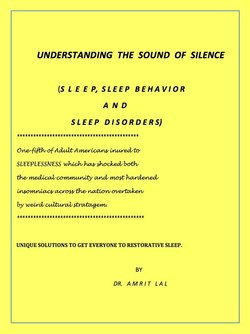Читать книгу Understanding the Language of Silence - Sleep, Sleep Behavior and Sleep Disorders - Dr. Amrit Lal - Страница 9
На сайте Литреса книга снята с продажи.
THE BRAIN DURING SLEEP
ОглавлениеCharacteristics and stages of sleep are assessed by a brain-waves recording mechanism called polysomonography in a sleep laboratory. Through localization of brain functions involving electrical stimulation of different parts of the brain, some sleep–inducing sites have definitely been mapped. It has been demonstrated that sleep can be induced by electrical stimulation of certain areas of hypothalamus in the brain. The basal forebrain, including hypothalamus, is an important region for NREM (non-rapid eye movement) sleep while the brainstem region known as the peons is critical for inducing REM (rapid eye movement) sleep. The peons also send signals generating characteristics of REM sleep. The brain site such as thalamus generates many of the brain rhythms in NREM sleep that we see as Electroencephalography (EEG) patterns. EEG patterns recorded during REM sleep show very fast and desynchronized activity that is more random than those recorded during NREM sleep.
Nerve cells (neurons) located in the brain stem or at the base of the brain determine whether we are awake or asleep. There is also an evidence that neuro-chemical molecule adenosine is an important sleep-inducer. It may be interesting to note that caffeine binds to and blocks some cell receptors that have an affinity for adenosine. In other words caffeine dissipates sleep by binding to adenosine receptors and preventing it from delivering fatigue signal to increase one’s propensity to fall asleep.
As explained above sleep urge is the function of “homeostatic” that is the balance between the elapsed time when we well-slept last and circadian rhythm (body’s own biological clock) which determines the ideal time for a well structured and restorative sleep. This balance starts building up as soon as we wake up after a nighttime sleep and continues till we again “hit the sack.” The process restarts when we again wake up in the morning after a nighttime sleep. As outlined in Wikipedia, “The Circadian Rhythm is set up in a beautiful way to over-ride the homeostatic drive for sleep.”
Sleep is a cyclical process with its main feature, circadian rhythm, occurring within a period of 24 hours to elaborate this cycling through stages of sleep. Body’s internal clock influences circadian rhythm or “morningness” or “eveningness,” or “lark” versus “owl” tendency which determines many personality traits. According to a study distributed by The American Academy of Sleep Medicine, “About one half of the population are daytime people, about one-quarter are moderate to extreme morning types, and about one-quarter are moderate to extreme evening types - knowing one’s own type is important for workers who want to maximize job performance, productivity and personal health.”
Further research suggests that during sleep there is an accelerated secretion of a particular hormone (Melatonin – also called “hormone of darkness” because it is secreted at night hours of darkness only) by pineal gland in the brain. Melatonin helps us sleep according to sleep researchers. Fluctuations in Melatonin levels influence our desire to stay awake or go to sleep.
During evolution, sunlight exposure determined what our Melatonin levels were. Our bodies still respond to Melatonin in the same way we did thousands of years ago. The difference today is that we now have many other sources of light mimicking sunlight, which upsets our body clocks/sleep cycle disrupting natural cycle of melatonin secretion. In a study of nearly 24,000 women ages 40 to 79 sleep deprived women had a greater incidence of breast cancer than those women who had an adequate amount of sleep. The increased risk may be due to diminished secretion of sleep hormone melatonin.
